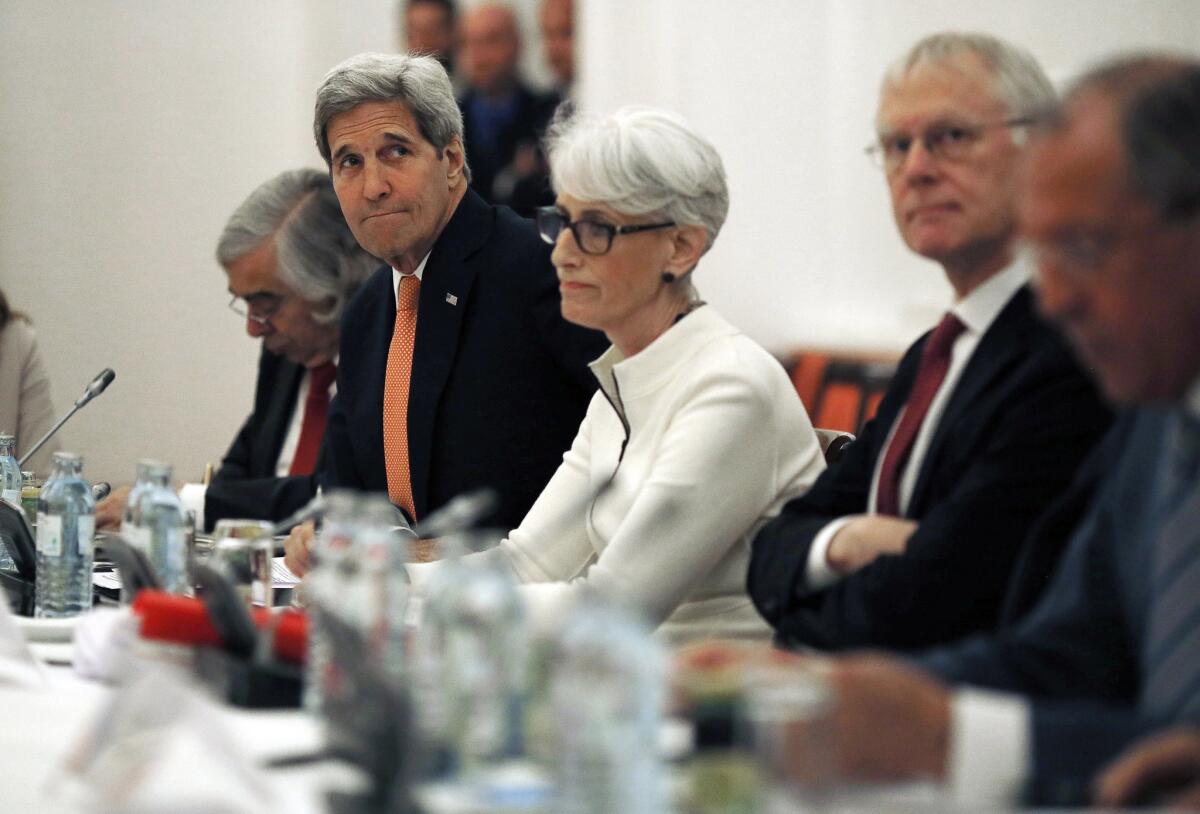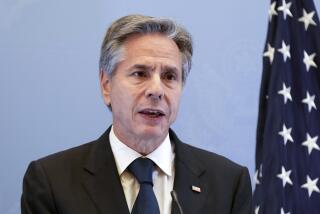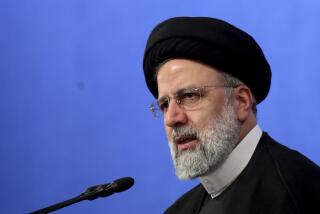Diplomats prepare to announce landmark deal on Iranian nuclear program

U.S. Secretary of State John Kerry, second from left, meets with foreign ministers and delegations from Germany, France, China, Britain, Russia and the European Union at a hotel in Vienna on July 13.
After 17 days of often-grueling negotiations, diplomats Monday night prepared to announce terms of a landmark deal aimed at preventing Iran from building a nuclear weapon for at least a decade.
The two sides had remained divided on several issues until a final round of talks Monday, despite widespread predictions over the weekend that an agreement was near.
Terms of the deal, one of the most far-reaching diplomatic accords in decades, were expected to be announced early Tuesday morning here, barring any further last-minute snags.
Announcement of an agreement would be almost certain to set off a renewed round of intense debate in the U.S. and internationally. Critics in the U.S. and elsewhere have acknowledged they have little chance of blocking a nuclear deal – a move in Congress to vote it down after a 60-day review period would be vetoed by President Obama – but they aim to undermine it politically in hopes that a future president would abandon it.
Negotiators from Iran, the United States, France, Britain, Germany, Russia and China have spent the last two years seeking a deal. Its goal is to resolve a top-priority security threat by applying unprecedented scrutiny to Tehran’s nuclear complex and scaling back its most sensitive nuclear activities.
Currently, U.S. intelligence agencies estimate the Iranians are two to three months away from being able to build a nuclear bomb. The deal is designed to extend that period to a year by reducing Iran’s stockpile of enriched uranium, cutting its ability to enrich uranium or produce plutonium in the future and placing its known and suspected nuclear sites under international surveillance.
In exchange, Iran’s economy would get a boost worth billions of dollars.
In the final round of talks, issues that remained in dispute, according to officials from several nations, included details of the relief that Iran would receive from international economic sanctions; the wording of a United Nations Security Council resolution intended to put the deal in place; and Iran’s demand that, along with removing other sanctions, the U.N. should lift an embargo on its trade in missiles and conventional arms.
How those disputes were resolved will not be known until Tuesday, but many parts of the expected agreement are known.
Iran would be required to reduce its inventory of centrifuges, which are used to enrich uranium, from 19,000 to 6,000 and cut its stockpile of low-enriched, reactor-grade uranium from 22,000 to 660 pounds. To block any effort to build a plutonium-fueled bomb, Iran would be required to remove the core of its heavy-water reactor at Arak and will not be allowed to produce any weapons-grade plutonium.
Iran’s nuclear sites will be under heavy scrutiny. United Nations inspectors will be entitled to gain access to sites and interview technicians if there is evidence that illegal activity might be taking place.
The agreement would be implemented in several stages. Over the next several months, Iran is expected to begin taking steps to scale back its nuclear activities, while the United States and Europe make arrangements to lift their sanctions. Once the United Nations’ nuclear watchdog agency has verified Iran’s steps, the U.S. and Europe would lift their sanctions.
Iran is expected to receive a quick boost from the deal from the release of some assets currently in frozen bank accounts in the West. When Iran’s compliance has been verified, a process likely to take several months, U.S. and European Union sanctions would be lifted.
Ultimately, Iran would be allowed to bring home overseas assets estimated to be worth $100 billion to $150 billion.
The agreement could improve America’s troubled relationship with Iran and is likely to have far-reaching effects in the Middle East. Already, oil prices have slumped, partially in anticipation of increased production from Iran, which has the world’s fourth-largest oil reserves. The country is expected to be able to pump as much as 1 million additional barrels a day once sanctions on its oil industry are removed.
Administration officials view the deal as Obama’s crowning foreign policy achievement.
But critics of the diplomacy, including most Republican lawmakers and some Democrats, as well as allies including Israel and Saudi Arabia, fear that the deal will fail to restrain Iran’s nuclear program because of many concessions.
The critics also fear that even if Iran complies with the deal, it will grow more powerful over the next decade because of the economic benefits the country will reap from the lifting of sanctions. When the deal expires, they say, a wealthier, stronger Iran could resume its pursuit of a nuclear bomb.
The deal is essentially a bet that it is safer to trade sanctions relief for curbs on Iran’s nuclear activities now rather than allow the Islamic Republic to continue a nuclear development program that was already on the threshold of weapons capability.
Administration officials argue that the alternatives to negotiations offered little hope of blocking Iran’s progress. Although economic sanctions and a determined campaign of sabotage by the U.S. and Israel have slowed Iran’s nuclear program, they have not stopped it. U.S. officials argue that the sanctions would be likely to have diminishing effect over time because the international coalition backing them would inevitably fray.
A military strike against Iran would also be a poor alternative, administration officials say. Although the U.S. has so-called bunker-buster bombs that could penetrate Iran’s deeply buried nuclear sites, even a sustained bombing campaign would halt the program for only a few years, they say. At the same time, an attack would probably strengthen the desire of Iran’s leaders to acquire a bomb.
The accord would cap a fitful diplomatic saga that reaches back to 2002, when disclosure of Iran’s secret construction of two nuclear enrichment plants raised fears that Tehran was planning a race to a bomb. Negotiations have broken down many times and succeeded only after both sides agreed in 2013 to painful compromises.
The deal is not a treaty, but a “political understanding” between the two sides. It will not be signed by the parties this week, but would be given international legitimacy when the United Nations Security Council votes on a resolution that would replace six previous sanctions measures and enshrine key elements of the deal.
Obama has the authority to issue waivers of many U.S. sanctions. The sanctions would remain on the books, however, unless Congress voted to end them. The deal is designed to preserve the ability of the U.S. to “snap back” the sanctions if Iran violates the terms of the agreement.
Critics have warned that improving Iran’s economy and ties with the outside world will bolster the country’s authoritarian government and enable it to expand efforts to gain influence in such countries as Yemen, Iraq, Syria and Lebanon. They predict that this economic boost will sharpen the conflict between Iran and its regional rivals, such as Saudi Arabia.
But Obama has predicted that the deal, by strengthening relative moderates in Iran, could gradually point the country in a less bellicose direction. He has held out hope that a deal might improve relations between the U.S. and Iran, two countries that have carried on a bloody rivalry since the 1979 Iranian Revolution, though he’s said the deal would be worthwhile even if that does not happen.
For the latest on the nuclear negotiations, follow @RichtPau
More to Read
Start your day right
Sign up for Essential California for news, features and recommendations from the L.A. Times and beyond in your inbox six days a week.
You may occasionally receive promotional content from the Los Angeles Times.







